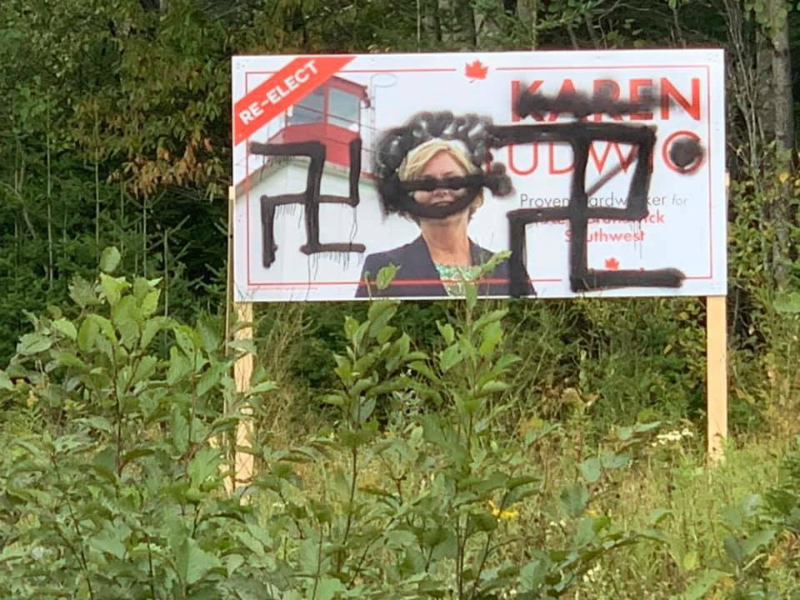Election campaign materials across the country have been defaced with swastikas and other graffiti in recent days.
As of Sept. 18, The CJN was aware of five such instances of vandalism, impacting NDP candidate Rachel Blaney in Victoria, Conservative candidates Michael Forian and Mariam Ishak and Liberal candidate Soraya Martinez Ferrada in Montreal, and Liberal candidate Karen Ludwig in New Brunswick.
Ran Ukashi, the national director of B’nai Brith Canada’s League for Human Rights, said he does not believe the incidents were connected, as they took place over the span of a few days in various locations throughout the country. But he does believe that the swastikas are indicative of the current permissive climate with regards to espousing anti-Semitic ideas, even though the graffiti did not specifically target Jewish candidates.
“More and more, the symbol of the swastika and neo-Nazi graffiti are becoming more prevalent in the kind of vandalism we’re seeing targeting political billboards and campaign posters and what have you. We have, of course, seen that in the past in other elections, including provincial elections,” he said. “It appears to be increasing compared to previous years.”

(Provided by B’nai Brith Canada)
Ukashi also finds the graffiti concerning because he believes it’s possible that the increase in anti-Semitic symbols and discourse could presage a rise in anti-Semitic violence.
“A lot of these acts of vandalism do lead ultimately to other acts that lead to violence against the Jewish community, which we have seen in Canada, we’ve seen in the United States and elsewhere,” he said. “It’s kind of like keeping a pulse on what’s going on. The more we see this publicly out in the open, the more we’re understanding that people who hold these ideas are willing to increasingly act on them.”
As it’s not possible to know the motivations behind the people who vandalized the election materials with swastikas, Ukashi did acknowledge that it’s possible that “they want to express a swastika because it’s taboo to do so … they want to get a rise out of people.” But whatever the reason for the vandalism, Ukashi said it’s important to always take it seriously, for two main reasons.
The first is because, even if the person’s intent was to seek a sort of “perverse thrill,” and not to communicate hatred towards Jews, Jewish people will still feel that hatred, as it is impossible to separate it from the symbol. And second, since it is not possible to know the motivations behind the vandals, Ukashi said it makes sense to assume the intent is to communicate a hate-filled message, and therefore we should respond accordingly.
Some online commenters tried to blame the instances of anti-Semitic graffiti on one party or another, by saying, for example, that Prime Minister Justin Trudeau wasn’t doing enough to combat anti-Semitism, or that Conservative Leader Andrew Scheer wasn’t taking a stand against bigotry on the right. But Meyer Siemiatycki, a professor emeritus of politics at Ryerson University, doesn’t buy those theories.
“Sadly, in this case, this is a non-partisan, across the political party spectrum expression of anti-Semitism, and the only appropriate comment from any political party on this is to reject and denounce expressions of anti-Semitism – not to suspect that somehow your political opponent is behind this,” he said.
Siemiatycki said there are a few possible interpretations of the incidents, but his “default position” is that people are taking advantage of the national media attention given to the upcoming election to spread their anti-Semitic messages to as wide an audience as possible.
READ: INSIDE THE JEWISH-CANADIAN ELECTION BATTLEGROUND
“Elections have many wonderful qualities, but there can also be a dark side, and the dark side is that it’s almost an invitation for anyone who has any issue they’re concerned about to express themselves in whatever way they feel can get an audience. And a lawn sign can be an appealing signboard to those who want to convey a message of hate,” he said.
Siemiatycki also said it’s possible that these incidents were co-ordinated in some way, perhaps orchestrated by members of extreme-right groups, as they have become “more and more vocal and assertive in trying to get their message out.”
Michael Forian, the Conservative candidate for the riding of Ville-Marie–Le Sud-Ouest–Île-des-Sœurs in downtown Montreal whose posters were defaced with anti-Semitic graffiti, said the vandalism is proof that hate is alive and well. He was disturbed by the graffiti, especially because members of his family fought against the Nazis. In fact, his great-grandfather was a Polish military intelligence officer who died in the Holocaust.
Forian said multiple candidates and parties filed police reports once they became aware of the defaced signs. He also said that volunteers have been taking down signs with hateful symbols on them and contacting campaign teams to replace them, with the goal of “vanquish(ing) this message of hate as quickly as possible.”
“I can’t even imagine why somebody would do something like this.… The only thing that we can do is come out and denounce it immediately and call it for what it is, and it’s hate,” he said. “When you see hate, you have to call it out.”
